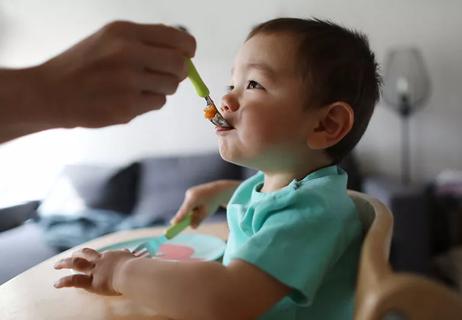Be a good role model, set family meal times and involve your kids in meal planning

You’ve probably heard the old adage, “You are what you eat.” While your child isn’t going to literally morph into a fruit salad or a loaf of garlic bread, the food choices they make (and that you make for them) have a very literal impact on their bodies.
Advertisement
Cleveland Clinic is a non-profit academic medical center. Advertising on our site helps support our mission. We do not endorse non-Cleveland Clinic products or services. Policy
Poor eating habits in childhood can follow your kids well into adulthood, causing health issues and difficult relationships with food. By teaching kids about food that’s good for their health when they’re little, you can set them up for a lifetime of wellness.
“It’s never too soon to start teaching kids good eating habits,” says pediatric dietitian Diana Schnee, MS, RD, CSP, LD.
Food serves a lot of purposes. It can be tasty, fun and culturally important, and eating with loved ones provides opportunities for bonding and togetherness. But food is also science. And kids need healthy foods — full of the right vitamins and minerals — in the right amounts, to help them grow.
“Food is the first type of medicine,” adds pediatric cardiologist Christina Fink, MD. “Kids need good nutrition to live, grow and be healthy. But inadequate or improper types of nutrition can lead to childhood obesity, high cholesterol, high blood pressure, prediabetes and further issues once in adulthood.”
These tips can help you teach your kids eating habits that will equip them for a healthy future and a positive relationship with food.
Kids thrive on routines, so try to eat together as a family and serve meals and snacks around the same time every day if possible. This way, kids are less likely to graze and overeat. It’s also a good time to teach them healthy eating habits and table manners.
Advertisement
“Eating as a family is good for social, emotional and developmental purposes, and having meals together is an opportunity to teach kids about portions,” Dr. Fink says. “For example, you can show them that half our plates should be non-starchy vegetables and some fruit.”
Limit meals to a reasonable length of time, no longer than 30 minutes. You can even set a timer to reinforce this expectation and help kids stay focused during meals.
Is breakfast really the most important part of the day? Well, they’re all pretty important — but eating a healthy breakfast gives your child the fuel they need to make it through the day and help them grow and develop properly.
“It doesn’t have to be a large or elaborate meal,” Dr. Fink says, “just something that’s nutritious to get their bodies going and fuel their metabolism for the day.”
Definitely don’t stress about the idea of making an elegant breakfast from scratch every morning. Instead, turn to easy, kid-friendly, dietitian-approved breakfast ideas, like whole-wheat toast with natural peanut butter or plain Greek yogurt sprinkled with a fiber-rich, low-sugar cereal and a handful of fruit.
It can feel nearly impossible to deal with kids’ picky eating preferences, but with intentionality and patience, you can nip it in the bud early.
Continue to offer a variety of foods during meals to encourage exploration and allow for exposure. Schnee says it’s good to let kids (even picky toddlers) choose from what’s on their plate, and it’s OK if they choose just one or two things. But don’t make separate meals for picky eaters.
“You’re not a short-order cook,” she says. “Make a decision about what you will serve, and stick to it. If your child asks for something else, you can explain that it is not on the menu for the day but offer to prepare it another night.”
For kids who are in kindergarten and older, Dr. Fink suggests instituting a three-bite rule. “Your child should try at least three bites of a food, just to give it a chance. Even then, they will need to try the food 15 or more times before they can say they truly don’t like it,” she says. “Sometimes, it’s just trial and error to figure out their palate.”
Like the rest of us, kids love having a say in what they do, and giving them choices allows them to feel both independent and invested. Here are some ways you can allow them to participate in the creation of family meals and snacks:
Advertisement
Speaking of letting kids participate, you can turn your family grocery shopping trips into educational life lessons disguised as adventures (and, of course, time spent together).
“When you go to the store together, you can show them different types of foods and start teaching them how to read nutrition labels,” Dr. Fink suggests. “You can review various ingredients with them and talk about carbohydrates, sugar and fat content — all in age-appropriate ways, of course.”
If your child’s only opportunity to drink water during the school day comes from a fleeting pass at the drinking fountain, they may be thirsty or even dehydrated when they get home — and they might not even realize it.
“When your kids get home from school, have them drink some water instead of grabbing a snack right away,” Dr. Fink recommends. “If they’re not getting enough hydration, sometimes kids think they’re hungry when they’re actually thirsty.”
Snacking is practically a national pastime, but it’s not a healthy way to pass the time. To instill healthy snacking habits, try to teach your kids not to snack out of boredom.
“Snacks can be healthy and nutritious and we enjoy them because they taste good, but we shouldn’t eat just because we don’t have anything else to do,” Dr. Fink states. “Instead, fill that time with other activities that are good for growth and development.”
Advertisement
You know the phrase “Stop and smell the roses”? The same idea is true for food. When you take the time to enjoy the tastes, textures and sensations of your food, you begin to really appreciate the experience. This is called mindful eating.
When you give your kids a piece of an apple, you can say, for example, “Look at this pretty red color. See how crunchy it is?” This sets the tone for analyzing and appreciating food, which also helps lessen the chances of overeating. When kids are eating, and they’re already accustomed to noticing and enjoying the flavors and textures of each bite, they’re likely to eat more slowly and recognize when they’re full.
Speaking of mindful eating, it’s important that all of us, even kids, learn to recognize internal hunger and fullness cues.
“Younger children, like toddlers, are very good at self-regulating,” Dr. Fink says. “They’ll eat food until they’re not hungry. Encouraging them to eat more than they’re hungry for can actually introduce a pattern of overeating.”
So, don’t insist that kids clean their plates in order to get dessert. “There’s no magical quantity for how much they need to eat to earn dessert, but they should have made a reasonable attempt to try the meal,” Schnee adds.
Advertisement
When you make a food entirely off-limits, you risk making your child more interested in that food — and then, they’re likely to overindulge in it whenever they get the chance. Instead, take a balanced approach by encouraging smaller portions and healthier treats.
You can also model good eating habits in the treats your child sees you eat, too. For example, it’s OK to go out for ice cream, but everyone in the family can order the kiddie size, picking frozen yogurt with dark chocolate instead of sprinkles and hot fudge.
“Find ways to incorporate these foods on occasion, and your kids will have a healthier approach to them,” Schnee advises.
Eating healthy with your kids doesn’t mean you can never eat out — even at fast food restaurants. But look for opportunities to balance your unhealthy food choices with smarter, healthier ones. “Everything in moderation,” as another old saying goes.
“If you’re having something unhealthy, think about how can you counterbalance it,” Dr. Fink suggests. Look for simple, healthy swaps, like switching out French fries for apple slices, soda for milk, white bread for whole wheat and so on.
OK, OK, so this isn’t a nutrition tip. But when it comes to health, diet and exercise are inextricably linked. “Kids just aren’t as active as they were 10 or 20 years ago,” Dr. Fink says. So, it’s important to teach kids about the joy (and healthfulness) of movement.
The U.S. Centers for Disease Control and Prevention (CDC) says that kids ages 3 to 5 need to be active throughout the day, while kids ages 6 and older need about 60 minutes of physical activity per day.
This doesn’t mean putting your kid through a cardio circuit, though. Just be sure they get moving, period — whether it’s running around outside with friends or going on bike rides with the family,
If imitation is the sincerest form of flattery, then parents should consider themselves seriously flattered. Your kids pick up the habits and values you model for them, so make sure you’re demonstrating ways of life that you want them to emulate.
“Being healthy as a family is so important,” Dr. Fink notes. “If you want your children to have healthy habits, then you as a parent need to take on those habits, too.”
Let your kids see you trying new cuisines, cooking meals at home, shopping for healthy foods and embracing movement and exercise.
To hear more from Dr. Fink on this topic, listen to the Health Essentials Podcast episode “How to Talk to Your Kids About Healthy Nutrition (And Why It’s Important).” New episodes of the Health Essentials Podcast publish every Wednesday.
Learn more about our editorial process.
Advertisement

Look for snacks that are low in sugar and high in fiber, protein and healthy fats

Fiber can lower blood pressure and promote healthy bowel function

Eating wisely at lunch can result in a better practice after school

Insights and healthy tips for parents to help your child achieve their recommended weight

Make lunch fun, creative and colorful

No amount of caffeine is safe for kids under 12, and kids 12 to 17 should be cautious about how much they consume

They aren’t unhealthy, but they’re probably a waste of money

When and how to introduce solid foods into your baby's diet

Type 2 diabetes isn’t inevitable with these dietary changes

Applying a hot or cold compress can help with pain